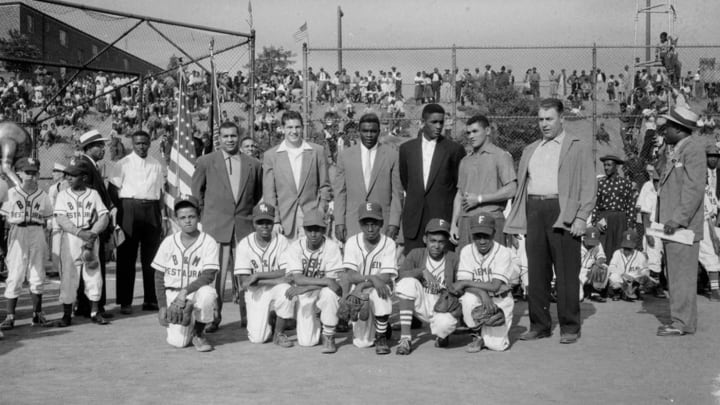Carlos Bernier: A Pioneering Pirate

By Thomas E. Van Hyning
Pittsburgh’s Kennard Field, in the city’s Hill District, was the place to be Friday morning, May 29, 1953, for the Uptown Little League opening day ceremonies. Carlos Bernier represented the Pittsburgh Pirates at this ceremony, as did three Brooklyn Dodgers: Jackie Robinson, Roy Campanella and Joe Black.
Bernier had a pleasant conversation with Robinson during the Little League festivities that day, per an event photo.
Why were these ball players attending this dedication? They were representatives of the team’s black players. The Dodgers contingent included Robinson, the man who broke Major League Baseball’s color line on April 15, 1947. The lone Pirates representative holds a similar distinction as the first black Pirates player.
Pittsburgh’s Integration Pioneer
Though baseball historians have credited Curt Roberts as being the first black player on the Pirates, another player, the Puerto Rican Carlos Enrique Bernier Rodríguez, merits consideration if not the outright claim to the role of Pittsburgh’s integration pioneer. Bernier’s debut on April 22, 1953, came a full year before Curt Roberts played for the Pirates. There is plenty of evidence that not only a number of his contemporaries but also Bernier himself identified as black.
The Pittsburgh Courier’s Wendell Smith, arguably the nation’s most widely read black sportswriter of the time, placed Bernier on a list of African-American players slated for a banner season in his “Sports Beat,” on April 18, 1953. Smith is an important barometer since he had initially covered Robinson’s season pioneering baseball’s racial integration with the Dodgers.
Perhaps more significantly, Bernier considered himself black. This is what both family members and his biographer Charles F. Faber noted about his racial identification upon closer review.
Bernier had taken on a role of senior teammate along with Lino Donoso, a Cuban pitcher, who encouraged Hall of Famer Roberto Clemente to refrain from emotional outbursts and temper tantrums in Fort Myers, Fla., during spring training in 1955. They viewed it as important to advice their younger teammate about the challenges of being in a Jim Crow state for spring camp.
Pittsburgh’s Hill District
Kennard Field was at the intersection of Reed and Kirkpatrick streets. This location mattered historically when it came to black Pittsburgh.
The Hill District was the Steel city’s oldest black community. It was even called “Little Haiti” in 1804 after the rebellion by slaves and subsequent independence of Haiti that year.
Early residents of the Hill District were middle-class free blacks. During the 1910s, the Hill attracted migrants from other parts of the U.S., namely the rural South. There were many Jazz musicians in the area.
By the 1930s the Hill was considered “the crossroads of the world” by entrepreneurs such as Gus Greenlee, owner of Crawford Grill No. 1 starting in 1933, and the staff of the Pittsburgh Courier such as photographer Teenie Harris, who captured the action in the district.
The Hill also mattered in terms of black baseball in Pittsburgh. One of the greatest Negro League teams emerged from the Hill. The Pittsburgh Crawfords, owned by Greenlee, were named after the Crawford Bath House in the Hill District.
And when it came to opening day ceremonies at Kennard Field in the Hill District, it was Bernier—Pittsburgh’s only black player—who officially represented the Pirates on Friday, May 29, 1953.
Bernier’s Connection to Segregation
Family relatives of Bernier stressed how he identified as black and dealt with racial segregation. Dr. Miguel A. Torres Bernier—Bernier’s nephew—emphasized his uncle was the first Pittsburgh Pirates player to deal with segregation.
Family stories passed down related how Carlos Bernier dealt with the realities of race as a black Puerto Rican in the 1950s U.S. mainland. His nephew shared how Bernier’s travel arrangements were driven by a fear of encountering southern racism and Jim Crow.
His nephew remembers that Bernier’s second wife said that he drove from Los Angeles to New York through the upper Midwest after the 1952 and 1954 through 1957 Pacific Coast League seasons.
He took the longer route to avoid driving through Arizona, Texas and the deep South because he feared racism and the Ku Klux Klan. Bernier then caught a flight to San Juan, Puerto Rico, from New York.
Bernier Makes it to Pittsburgh
Bernier’s performance for the 1952 Hollywood Stars was noteworthy. He batted .301 with nine home runs, 79 RBI and a PCL-leading 105 runs and 65 stolen bases.
This motivated the Pirates to purchase his contract. Some Bernier supporters actually joked about his acquisition by Pittsburgh, most prominently actor-comedian Groucho Marx, who joked that Bernier’s move from the first-place Stars to the last-place Pirates would be a demotion.
Bernier benefitted from the Pirates’ 1953 spring training in Havana, Cuba, led by manager Fred Haney. Bernier was not subject to separate quarters for blacks, as was the case in Fort Myers, in 1955, when he, Clemente and four other teammates lived in the black Dunbar Heights neighborhood.
Bernier stole 15 bases in 1953. Bernier’s three triples in a game versus Cincinnati on May 2, was duplicated by Clemente in 1958. A slump that started in mid May affected Bernier’s playing time. He was not in the lineup for the day game versus Brooklyn on May 29, following the morning’s Little League ceremony.
The two-hour and 15 minute contest ended in a 7-4 win for first-place Brooklyn.
Bernier’s Baseball Legacy
Bernier was the first person of color to wear a Pittsburgh uniform and the first of 40 Puerto Rican players, including Bobby Bonilla and John Candelaria, to play for the Pirates. Bernier’s pioneer legacy should be recognized for reasons on the field as well as beyond, including his representing the Pirates at the 1953 Uptown Little League opening day ceremonies.
Featured Image: Teenie Harris Archive/Carnegie Museum of Art